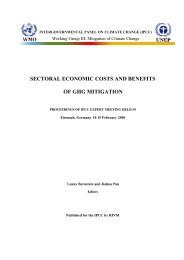Pacific Islands Environment Outlook - UNEP
Pacific Islands Environment Outlook - UNEP
Pacific Islands Environment Outlook - UNEP
Create successful ePaper yourself
Turn your PDF publications into a flip-book with our unique Google optimized e-Paper software.
40<br />
POLICY RESPONSES<br />
Economic instruments<br />
It is clear that the key to sustainability of resource use<br />
and the achievement of environmental conservation is<br />
the integration of environmental safeguards in<br />
economic decision-making. This is a complex task,<br />
which needs to be addressed at all levels, from the<br />
national policy level to the local level. To achieve longterm<br />
economic and environmental viability, some<br />
comprehensive institutional and legal changes need to<br />
be made. These include the introduction of integrated<br />
mechanisms for the generation of economic and<br />
environmental policy, and the enactment of legislation<br />
at national and provincial (or state) level to ensure that<br />
policies can be carried out within a consistent and<br />
enforceable legal framework.<br />
Techniques of environmental accounting and<br />
economics have evolved in recent years to take greater<br />
account of the sustainability of welfare and to provide<br />
improved guidance for environmental policy. These may<br />
be of particular interest to small island states, given their<br />
heavy dependence on the natural environment. Initial<br />
work on environmental accounting and economics in the<br />
region (Fairbairn and Tisdell 1994) identified an<br />
underlying need to better quantify natural stocks and<br />
environmental assets for the successful introduction of<br />
these techniques. Many examples of economic<br />
instruments are being used globally but there is no<br />
explicit country or regional effort to examine their<br />
applicability to PICs. Examples of the use of economic<br />
instruments in island communities have been shown to<br />
produce benefits (SPREP 1998e). There has been little<br />
concerted effort towards the use of economic policy<br />
instruments, in spite of their encouragement in country<br />
NEMS produced in the early 1990s.<br />
Examples of economic instruments currently used<br />
in the PICs include:<br />
●<br />
●<br />
●<br />
access fees and licensing of foreign fishing vessels<br />
(Preston 1997);<br />
deposit-refund schemes for glass bottles<br />
(GOWS 1994);<br />
user fees for park, reserve or coastal access to<br />
customarily owned land (SPREP 1993b).<br />
The success of the instruments has not been formally<br />
evaluated. Their overall impact on environmental<br />
protection and enhancement needs to take into account<br />
the large subsistence economy that still functions in the<br />
region. Communal management of resources can be<br />
relatively efficient and can provide social security at the<br />
village level. However, titles of the local community need<br />
to be definite and settled and there may be a need to<br />
improve communal or village governance. Once the titles<br />
of local communities become definite this should establish<br />
a legal responsibility for the use of these resources. For<br />
example, a village may be held to be liable for adverse<br />
environmental spillovers on other villages caused by its<br />
activities, and compensation or penalties may be imposed;<br />
or, if favourable externality is created by the village, be<br />
eligible for reward. Furthermore, within the village greater<br />
consideration should be given to the rights and<br />
responsibilities of resource owners.<br />
In many cases, village leaders would benefit from<br />
more accurate information about environmental<br />
changes and risks in the local area, as well as their<br />
possible impacts on other communities. Negotiated<br />
intercommunity settlement of issues of mutual<br />
concern, such as impacts of environmental spillovers,<br />
should be encouraged.<br />
Industry and new technologies<br />
The countries of the South <strong>Pacific</strong> are small and in<br />
general do not rely heavily on an industrial base. The<br />
necessity for cleaner and innovative production<br />
processes is therefore perceived to be less than in more<br />
industrialized nations. As a result governments have not<br />
given the imposition of strict controls over industry a<br />
high priority, sometimes with adverse impacts.<br />
Initiatives in the areas of cleaner production processes<br />
and new technologies are at an embryonic stage within<br />
the region.<br />
The adoption of cleaner production processes has<br />
not been given a high priority by manufacturers in the<br />
region. The management of tailings waste at the BHP<br />
Ok Tedi mine in Papua New Guinea is one example.<br />
Due to cost considerations a tailings dam was not built<br />
and maintained, with tailings instead being discharged<br />
directly into the Ok Tedi river for many years. The<br />
resulting environmental damage to the river is now<br />
famous internationally as an example of inappropriate<br />
waste disposal and has cost the company many<br />
hundreds of millions of dollars in compensation.<br />
The SPC Plant Protection Programme is providing<br />
training on pesticide safety and the promotion,<br />
facilitation, training and research of non-chemical means<br />
of pest control: that is, biological control, integrated<br />
pest management, use of protein bait sprays and<br />
bagging of fruit to prevent infestation by fruit flies.

















